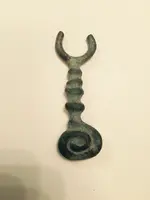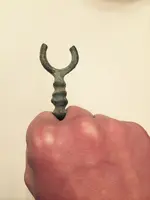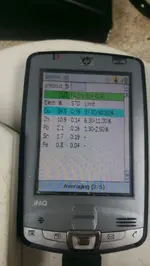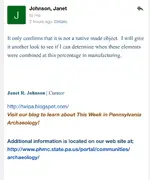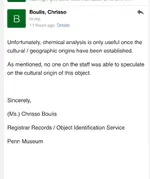from the one test it was 1.3% -2.5% lead. And you think it was machine made?
Typo from referring back to the wrong list in my post. But honestly, 2.5% vs 3.0% doesn't change the interpretation. Again, that amount is consistent with the amount that is routinely added to certain leaded brass alloys intentionally. We aren't talking about trace amounts that couldn't be removed from the other constituents during the production of the material. Also, as far as I understand it, lead doesn't really even become a true part of the "alloy" because it isn't soluble in copper; instead, it becomes a part of the material's structure by filling in porous imperfections. Here's some more information:
Lead is commonly added to many cast copper alloys. Because of the low solubility of lead in copper, true alloying does not occur to any measurable degree. During the solidification of castings, some constituents in a given alloy form crystals at higher temperatures relative to others, resulting in tree-like structures called dendrites. The small spaces between the dendrites can interconnect to form micropores. This micro*porosity is a consequence of the solidification process. The role of lead is to seal these intradendritic pores. This results in a pressure-tight casting, which is important for fluid handling applications.
Lead also allows the machining of castings to be performed at higher speeds without the aid of coolants because it acts as a lubricant for cutting tool edges and promotes the formation of small, discontinuous chips that can be cleared easily. This results in improved machined surface finishes. Lead also plays a role in providing lubricity during service, as in cast copper bearings and bushings. Lead does not have an adverse effect on strength unless present in high concentrations, but it does reduce ductility. Although lead-containing copper alloys can be soldered and brazed, they cannot be welded.
Now, as far as whether I think it is "machine made", I'm assuming you mean created by some sort of automatic process in which a machine does the job from start to finish. And the answer to that is, I don't know, but I'd say probably not. To be clear, the only thing I am saying we can be reasonably sure of is that the material used to create the piece was deliberately formulated for it's unique properties.
Anything beyond that point is speculation; we don't know who made it or how, and we don't know if they chose that material for convenience or because they wanted to leverage its properties. All that it implies is that, whoever made the piece
PROBABLY made it sometime between last tuesday and the point in history where industrial technology became modernized.
Even if we assume that the material was chosen by whoever made it because they found its properties desirable, that doesn't mean it had to have been made by a machine in a factory. Someone could have easily cast the piece by hand then machined it to remove imperfections like burs, scratches, etc. Machining doesn't mean created by a machine, per se. A human may guide that process. I'm not even saying necessarily that they would have even had to have machined it with a
power tool -- it's not like you can't perform machining with manually operated equipment.
But remember, there's no reason the person had to have picked the material for any other reason than the fact that it was available. You can literally go on ebay right now and buy scrap leaded brass and use it for whatever pet projects you might desire. Someone could have easily just used it because it was cheap, and had no idea that the specific alloy had certain qualities.
None of that however changes the intentions of the person who made the MATERIAL, though -- whoever made that almost certainly added lead on purpose. If would be quite the coincidence for there to be lead in the alloy by accident, but an even bigger coincidence that the amount of lead that showed up by accident also happens to be the amount that is an industry standard for creating leaded brass.
I'm not saying that it is 100% impossible that Chief Wamapoke created it thousands of years ago at the foundry in his wigwam. I'm saying, so far, what I'm seeing says otherwise. I'm not trying to beat you up here or give you a hard time. I hope it's a talisman worth millions of dollars. I really do. I'm just skeptical of that because the evidence is pointing in another direction. I'll stop bugging you.
Peace.
-mcl



